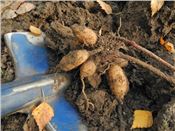Gardening Page
Give Summer-Blooming Bulbs A Second Chance, Store Them Overwinter

KEN JOHNSON
URBANA, ILLINOIS
Plants, such as cannas, caladiums, dahlias, elephant ears, gladiolus, and tuberous begonia, can make a great addition to the landscape.
These plants are commonly referred to as tender bulbs or summer- blooming bulbs. Not all of them actually grow from bulbs, but this is what their fleshy storage structures are commonly referred to as.
Other storage structures include corms, rhizomes, tubers, and roots.
“Unlike spring-blooming bulbs such as tulips and daffodils, these tropical plants will be killed by our cold winter temperatures if left outdoors,” says Ken Johnson, University of Illinois Extension horticulture educator. “So, if you don't want to have to buy new bulbs every year you’ll need to dig and store them indoors for the winter.”
Keep an eye on the plant’s foliage. Once the leaves begin to yellow or have been killed by a frost, the foliage can be cut back. The plants should be dug up within a few days of a frost to make sure rot- causing organisms don't enter the bulbs. Be careful when digging plants; if the bulbs are accidentally cut or “skinned” this creates an entry for pathogens that can quickly spread disease.
One way to avoid damaging the bulbs is to begin digging several inches away from the plant. Loosen the soil all around the plant, then lift the entire clump. After the clump has been lifted, remove any excess soil on the bulbs and discard any damaged bulbs. Using a digging fork can also help avoid causing damage to bulbs.
Most bulbs will need a curing, or drying, period before being stored for the winter. This can be as short as one to three days or as long as three weeks for plants like gladiolus and callas. While drying, keep the bulbs out of direct sunlight and in a well-ventilated area with temperatures around 60°F to 70°F.
Before storing bulbs inspect them again for any signs of disease or insects. Discard or treat any bulbs that may have pest problems. If you store them with 'healthy' bulbs the problems can spread over the winter and become a much larger problem.
“It's also a good idea to label what the bulbs are so that you know what's what come spring,” Johnson says. “There's not much more frustrating than having a bunch of bulbs and having no idea what's what.”
Dried bulbs can be stored in 2 to 3-inch layers of peat moss, sand, vermiculite, sawdust, or coconut coir in a well-ventilated container such as milk or bread crates or cardboard boxes. Try not to let bulbs touch one another while they are being stored. This will help prevent the spread of rot between bulbs.
Store bulbs in a cool area with temperatures around 40°F to 50°F such as an unheated garage or unfinished basement.
Periodically check your bulbs throughout the winter and remove any that appear to be rotting. Also, check the moisture levels. If bulbs are beginning to shrink and become wrinkled, moisten the media they are being stored in with a spray bottle. Just make sure not to moisten them too much because that can lead to rot.
For more information on plant care, connect with your local Illinois Extension county office at go.illinois.edu/ExtensionOffice. ∆
KEN JOHNSON: University of Illinois